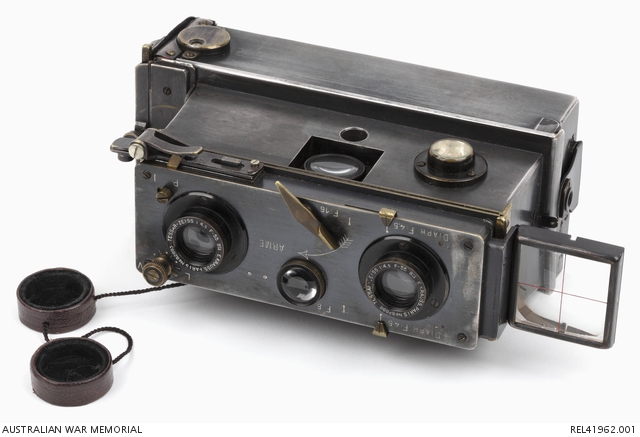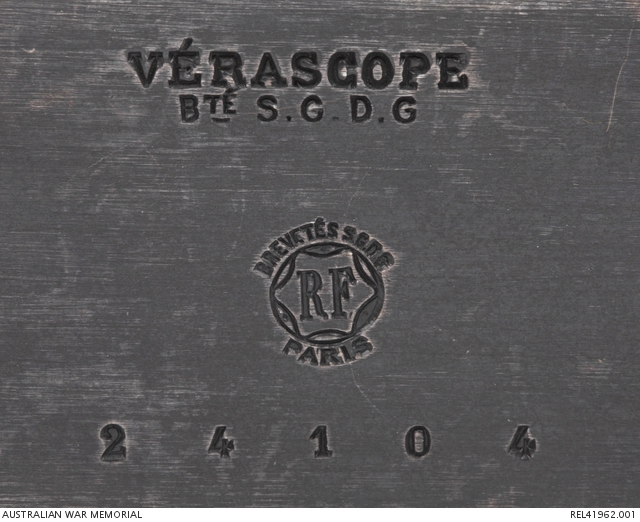| Places | |
|---|---|
| Accession Number | REL41962.001 |
| Collection type | Technology |
| Object type | Optical equipment |
| Physical description | Brass, Glass, Leather, Steel |
| Maker |
Richard Frere |
| Place made | France: Paris |
| Date made | c 1911 |
| Conflict |
First World War, 1914-1918 |
Verascope stereoscopic camera : Staff Sergeant Arthur Dumas Whitling, 1 Australian Auxiliary Hospital, AIF




Verascope stereoscopic camera with steel and brass body. The front of the camera is equipped with two adjustable apeture F 1:4.5 (f=55) Tessaro Zeiss lenses, (each labelled on the camera 'DIAPH F:4.5'), positioned approximately equal to the width of the human eyes - the resulting exposure produces two prints that are slightly different from each other, and allows the illusion of 3-D viewing when viewed with a stereoscope viewer.
There are two sliding controls top and bottom with which one can control the apeture width. Each lens is covered with a leather lens cap, lined on the inside with black velvet. These are linked together by a stout black thread and the thread is joined to a spirit level on the upper part of the camera. The front also features a brass lever which arms ('ARME') the shutter; and a steel shutter release which can be operated manually or by a shutter cable release (not included with this example).
One side features a flip-up glass direct viewfinder with red crosshairs applied to the glass - this is kept flat against the camera by a steel catch when not in use; the other is an angled viewfinder set equidistant between the lenses (associated with a prism arrangement inside the camera), with black crosshairs.
The film plate container or magazine at the rear of the camera is a sliding arrangement which advances the film (a unique 45 x 107 mm format of twelve glass plates) via a flip up metal handle; a counter at the base of the plate container (giving the number of exposure used, numbering 1 to 12) is enclosed in brass. In addition, the entire plate container can be removed and changed when the film has been exhausted. An impressed marking on the rear of the camera notes 'VERASCOPE / Bte S.G.D.G. / [mark of Richard Frere, Paris] / 24104'
Camera owned and used by 14529 Arthur Dumas Whitling, born 1876 at Parramatta, NSW, a civil servant who was 38 years old when he enlisted on 13 July 1915. Assigned to the Australian Army Medical Corps, Whitling was promoted to Corporal the day after his enlistment and Lance Sergeant (Clerk) on 12 August 1915. He joined the Australian Convalescent Depot departing from Sydney aboard HMAT Orsova on 14 July 1915.
Although Whitling was promoted to Staff Sergeant on 7 September 1915 and to Warrant Officer Class 1 on 1 March 1916, these appointments were never confirmed, resulting in Whitling's rank and dates of promotion becoming the subject of an internal AIF investigation. The result, in late 1919, was confirmation of his rank as Staff Sergeant but not as Warrant Officer. Whitling had a few things to say about this, and in his correspondence states 'As showing the muddle the records in my case were, I may instance the fact that whilst I held the position of Chief Clerk at the No 1 Australian Aux Hospital, Harefield Park, England, the OC Records London wrote for particulars regarding me, "as we have no trace of this man on record". That was strange, as I was one of the original members of the London Staff and had been paid at Headquarters for over a year!!'
'I subsequently had to reattest, notwithstanding that I personally handed over the attestation papers of myself & others on or arrival in London over a year previously.' A letter from Victoria Barracks written in 1921, querying Whitling's eligibility for the Victory Medal, notes: 'Whitling states that he enlisted specifically under Lieutenant Colonel Flashman, AAMC, on 5 July 1915, and embarked on Special Service.'
Whitling disembarked in London on 12 August 1915 and was taken on strength of Admin HQ, Medical Section at AIF Headquarters, Horseferry Road, London before being transferred to 1 Australian Auxiliary Hospital, Harefield on 25 August 1916. In accordance with the mess his records were in, Staff Sergeant Whitling wasn't allotted a regimental number until 17 January 1917. On 4 March 1918 Whitling was admitted to 1 Auxiliary Hospital with a medical condition which resulted in him being discharged from service with a 'debility'. He embarked from England board the Hospital Ship Kanowna for return to Australia, and was discharged on 26 June 1918, upon his return. He married Brenda on 16 September 1919 and died in 1973.
Arthur Whitling appears to have purchased this Verascope stereoscopic camera by 1911 at the latest, and used it well into the post Second World War period. He was an active member of the NSW Photographic Society until his death. Stereoscopic images acquired with the camera record such events as the visit of the American 'Great White Fleet' in August 1908, Sydney University's Commemoration Day of 1910, the SS 'Canonbar' aground near Lismore in 1911, embarkation images, views of Egypt and England from 1915 to 1918, views of Gallipoli and Anzac Cove, including the May 1915 Armistice to bury the Turkish dead, the Prince of Wales' visit to Australia, 1920 and Bradman at the 5th Test Match, SCG, 1933. A range of Autochromes also indicate that Whitling was an early and enthusiastic user of this colour system.
The Verascope was developed by the firm of Richard Freres (Richard Brothers) of Paris. Jules Richard (19 December 1848 - 18 June 1930) took over management of his father's camera business in 1871, and operated it with his brother. The Verascope, in its unique 45 x 107 mm format, entered the market early in the 1900s and was updated with a 35 mm version in 1913. Richard Freres released their own range of stereoscopic views of the Western Front and damage to French towns and villages in a series running to several thousand images.
Related information
Conflicts
Units
Places
People
Related Objects
- Carrying case, Verascope stereoscopic camera : Staff Sergeant Arthur Dumas Whitling, 1 Australian Auxiliary Hospital, AIF
- Verascope leather accessories box with accessories : Staff Sergeant A D Whitling, 1 Australian Auxiliary Hospital, AIF
- Two metre measuring tape : Staff Sergeant A D Whitling, 1 Australian Auxiliary Hospital, AIF
- Pair of yellow lens filters : Staff Sergeant A D Whitling, 1 Australian Auxiliary Hospital, AIF
- Packet of Dry Mounting Tissue : Staff Sergeant A D Whitling, 1 Australian Auxiliary Hospital, AIF
- Box of 'Primus' Spot Binding Strips : Staff Sergeant A D Whitling, I Australian Auxiliary Hospital, AIF
- Box of printing masks and discs : Staff Sergeant A D Whitling, 1 Australian Auxiliary Hospital, AIF
- Perfect Focussing Screen : Staff Sergeant A D Whitling, 1 Australian Auxiliary Hospital, AIF
- Autotype Prepared Paper for Oil Printing, Toned : Staff Sergeant A D Whitling, 1 Australian Auxiliary Hospital, AIF
- Pack of Colour Correctors for Autochrome plates : Staff Sergeant A D Whitling, 1 Australian Auxiliary Hospital, AIF